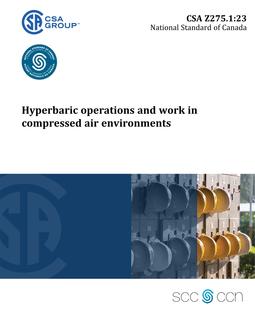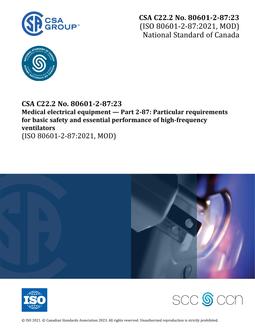
CSA Z275.1:23
Preface
This is the sixth edition of CSA Z275.1, Hyperbaric operations and work in compressed air environments. It supersedes the previous editions published in 2016, 2005, 1993, 1982, and 1974 under the title Hyperbaric facilities. For improved application to dive support and clinical settings, this edition has been significantly updated and reorganized to incorporate requirements from CSA Z275.3. As well, it has been technically updated to correspond with updates to other related standards in the CSA Z275 series of standards as well as with ASME PVHO-1. Changes to this edition include the following: a) updated definitions (Clause 3); b) updated chamber design requirements (Clause 4); c) added requirements for single-occupancy chambers (Clause 15); d) updated requirements for single and multiple hyperbaric chamber operators (Clause 18.2.3); e) added Clause 19on hyperbaric operations in support of compressed air environments; f) added Annex Ion single-occupancy clinical hyperbaric chamber operators; and g) added Annex J, which is a bibliography on offshore hyperbaric standards, regulations, and guidance documents. This Standard was developed by CSA Group with funding support provided by the Canadian Association of Administrators of Labour Law — Occupational Safety and Health (CAALL-OSH), including provincial and territorial governments, as well as the Government of Canada. CSA Group is solely responsible for the content of this Standard, and CSA Group and the funding bodies disclaim any liability in connection with the use of the information contained in this Standard. This Standard was prepared by the Subcommittee on Hyperbaric Facilities and Compressed Air Environments, under the jurisdiction of the Technical Committee on Occupational Diving and Hyperbaric Environments and the Strategic Steering Committee on Occupational Health and Safety, and has been formally approved by the Technical Committee. This Standard has been developed in compliance with Standards Council of Canada requirements for National Standards of Canada. It has been published as a National Standard of Canada by CSA Group.
Scope
1.1 General
1.1.1 Application
This Standard applies to hyperbaric chambers that have as their primary function the subjection of humans to pressure environments exceeding 1 atmosphere absolute, such as those required in a) diving operations; b) work under compressed-air conditions; c) medical treatment; d) training; and e) research.
1.1.2 Minimum requirements
This Standard establishes minimum requirements for the following of all hyperbaric chambers: a) operation; b) use; c) design; d) construction; e) maintenance; and f) testing. 1.2 Classification of human occupancy hyperbaric chambers
1.2.1 General
This Standard addresses the following classes of human-occupancy chambers: a) chambers used for clinical hyperbaric oxygen (HBO) treatment and/or for research purposes; b) chambers used for occupational diving operations; c) chambers used for tunneling and caisson operations; and d) hyperbaric chamber systems in support of offshore diving operations.
1.2.2 Chambers used for clinical HBO treatment and/or research purposes
A clinical HBO chamber is a hyperbaric facility that is overseen by a trained safety officer and a Level 2 or Level 3 hyperbaric physician, licensed in the jurisdiction in which they practice medicine, who adheres to the CUHMA Guidelines. Refer to Clause 17 for requirements applicable to research facilities used for human-subject research.
1.2.3 Types of hyperbaric chambers
1.2.3.1 Single-occupancy chamber
A single-occupancy or mono-place chamber is a hyperbaric chamber normally intended for the treatment of one person and capable of oxygen or air pressurization to a depth not exceeding 20 msw (66 fsw) for the provision of hyperbaric oxygen therapy, normally for clinical applications only.
1.2.3.2 Stationary (multiple-occupancy chamber)
A stationary chamber is a multiple-occupancy or multi-place hyperbaric chamber permanently installed in a vessel, platform, or shore-based facility and fixed to a permanent foundation, i.e., the vessel, platform, or building in which it is housed. Note: Single-lock multiple-occupancy stationary chambers may fall within this category. This is to be approved by the AHJ.
1.2.3.3 Transportable double-lock chambers (DDC) for occupational diving/hyperbaric operations in support of tunnel construction
A DDC is a multiple-occupancy hyperbaric chamber with two locks (compartments) that can a) operate to transfer personnel in and out of the main lock while maintaining pressure of the main lock; and b) be moved to a diving or caisson site to support on-site operations. This chamber may be temporarily set up as a stationary chamber during the period of a contract requiring hyperbaric support. Note: These chambers are used for emergency pressure-related ailments and/or for surface decompression procedures. They conform to the requirements stated in Clause 5.2 of CSA Z275.2 and are designed to operate at pressures of 6 ATA or greater.
1.2.4 Evacuation
An evacuation chamber is a single- or multiple-occupancy hyperbaric chamber that has as its primary function the emergency transportation under pressure of an individual at risk of, or suffering from, a pressure-related ailment. It has a minimum pressure rating of 3 ATA. This sub-class also includes hyperbaric rescue craft (designed in accordance with IMCA D 053) and hyperbaric stretchers (see Clause 11.7).
1.2.5 Submersible compression chamber
A submersible compression chamber (SCC) is a hyperbaric chamber that is capable of transporting personnel, at elevated pressures, from the surface to an underwater site and vice versa.
1.3 Hazards
The Standard addresses special hazards associated with the a) design; b) construction; c) operation; and d) maintenance of hyperbaric facilities. Note: Refer to Annexes A, B, and C for descriptions of potential hazards. Consideration and control of these hazards is the basis for criteria in this Standard.
1.4 Terminology
In this Standard, “shall” is used to express a requirement, i.e., a provision that the user is obliged to satisfy in order to comply with the Standard; “should” is used to express a recommendation or that which is advised but not required; and “may” is used to express an option or that which is permissible within the limits of the Standard. Notes accompanying clauses do not include requirements or alternative requirements; the purpose of a note accompanying a clause is to separate from the text explanatory or informative material. Notes to tables and figures are considered part of the table or figure and may be written as requirements. Annexes are designated normative (mandatory) or informative (non-mandatory) to define their application.
1.5 Units of measurement
The values given in SI units are the units of record for the purposes of this Standard. The values given in parentheses are for information and comparison only. Note: See Annex D for conversion table.
Product Details
- Edition:
- 6th
- Published:
- 05/11/2023
- ISBN(s):
- 9781488347825
- Number of Pages:
- 159
- File Size:
- 1 file , 2 MB
- Product Code(s):
- 2430585, 2430585
- Note:
- This product is unavailable in Russia, Ukraine, Belarus


